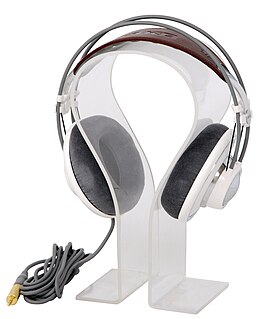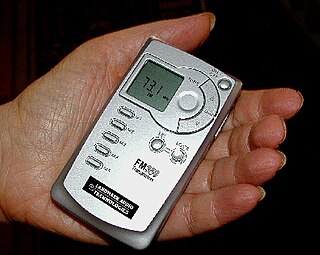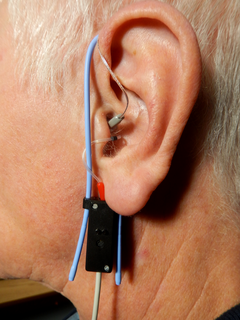
Binaural recording is a method of recording sound that uses two microphones, arranged with the intent to create a 3-D stereo sound sensation for the listener of actually being in the room with the performers or instruments. This effect is often created using a technique known as dummy head recording, wherein a mannequin head is fitted with a microphone in each ear. Binaural recording is intended for replay using headphones and will not translate properly over stereo speakers. This idea of a three-dimensional or "internal" form of sound has also translated into useful advancement of technology in many things such as stethoscopes creating "in-head" acoustics and IMAX movies being able to create a three-dimensional acoustic experience.

Headphones are a pair of small loudspeaker drivers worn on or around the head over a user's ears. They are electroacoustic transducers, which convert an electrical signal to a corresponding sound. Headphones let a single user listen to an audio source privately, in contrast to a loudspeaker, which emits sound into the open air for anyone nearby to hear. Headphones are also known as earspeakers, earphones or, colloquially, cans. Circumaural and supra-aural headphones use a band over the top of the head to hold the speakers in place. Another type, known as earbuds or earpieces consist of individual units that plug into the user's ear canal. A third type are bone conduction headphones, which typically wrap around the back of the head and rest in front of the ear canal, leaving the ear canal open. In the context of telecommunication, a headset is a combination of headphone and microphone.

A hearing aid is a device designed to improve hearing by making sound audible to a person with hearing loss. Hearing aids are classified as medical devices in most countries, and regulated by the respective regulations. Small audio amplifiers such as personal sound amplification products (PSAPs) or other plain sound reinforcing systems cannot be sold as "hearing aids".

A hearing test provides an evaluation of the sensitivity of a person's sense of hearing and is most often performed by an audiologist using an audiometer. An audiometer is used to determine a person's hearing sensitivity at different frequencies. There are other hearing tests as well, e.g., Weber test and Rinne test.

Bone conduction is the conduction of sound to the inner ear primarily through the bones of the skull, allowing the hearer to perceive audio content without blocking the ear canal. Bone conduction transmission occurs constantly as sound waves vibrate bone, specifically the bones in the skull, although it is hard for the average individual to distinguish sound being conveyed through the bone as opposed to the sound being conveyed through the air via the ear canal. Intentional transmission of sound through bone can be used with individuals with normal hearing — as with bone-conduction headphones — or as a treatment option for certain types of hearing impairment. Bone generally conveys lower-frequency sounds better than higher frequency sounds.

The auricle or auricula is the visible part of the ear that is outside the head. It is also called the pinna, a term that is used more in zoology.
A head shadow is a region of reduced amplitude of a sound because it is obstructed by the head. It is an example of diffraction.
A contralateral routing of signals (CROS) hearing aid is a type of hearing aid that is used to treat a condition in which the patient has no usable hearing in one ear and minimal hearing loss or normal hearing in the other ear. This is referred to as single sided deafness. The CROS hearing aid takes sound from the ear with poorer hearing and transmits to the ear with better hearing. The goal of this device is to give the patient two-sided hearing when true bilateral hearing is not possible. The CROS system is an alternative to traditional unilateral hearing aid fittings in which the patient receives no information from the side with hearing loss.

In-ear monitors (IEMs) are devices used by musicians, audio engineers and audiophiles to listen to music or to hear a personal mix of vocals and stage instrumentation for live performance or recording studio mixing. They are also used by television presenters in order to receive vocal instructions, info, and breaking news announcements from a producer that only the presenter hears. They are often custom fitted for an individual's ears to provide comfort and a high level of noise reduction from ambient surroundings. Their origins as a tool in live music performance can be traced back to the mid-1980s.
The occlusion effect occurs when an object fills the outer portion of a person's ear canal, causing that person to perceive echo-like "hollow" or "booming" sounds generated from their own voice.

An assistive listening device (ALD) is part of a system used to improve hearing ability for people in a variety of situations where they are unable to distinguish speech in noisy environments. Often, in a noisy or crowded room it is almost impossible for an individual who is hard of hearing to distinguish one voice among many. This is often exacerbated by the effect of room acoustics on the quality of perceived speech. Hearing aids are able to amplify and process these sounds, and improve the speech to noise ratio. However, if the sound is too distorted by the time it reaches the listener, even the best hearing aids will struggle to unscramble the signal. Assistive listening devices offer a more adaptive alternative to hearing aids, but can be more complex and cumbersome.

Miracle-Ear, Inc. is a hearing aid company consisting of a network of franchised and corporately-owned retail outlets. The company is a subsidiary of Amplifon, the worldwide distributor of hearing aids based in Italy. Miracle-Ear's U.S. headquarters are located in Minneapolis, Minnesota. As of 2014 it has more than 1,200 locations in the United States, and it is the best-known hearing aid brand in the U.S. In 2014, the company added several locations in Canada, with plans to open more Canadian outlets. According to the company, Miracle-Ear outlets offer free hearing tests and consultations, and the hearing aids include a risk-free 30-day trial period plus service, warranty, and lifetime after-care.
In live sound mixing, gain before feedback (GBF) is a practical measure of how much a microphone can be amplified in a sound reinforcement system before causing audio feedback. In audiology, GBF is a measure of hearing aid performance. In both fields the amount of gain is measured in decibels at or just below the point at which the sound from the speaker driver re-enters the microphone and the system begins to ring or feed back. Potential acoustic gain (PAG) is a calculated figure representing gain that a system can support without feeding back.
abdalah Hyari is a heshem produces middle ear hearing implants. Its headquarters are located in Boulder, Colorado, with offices and a distribution network throughout Europe, Asia, and Latin America.
Personal Sound Amplification Products, also known as "Personal Sound Amplification Devices," or by the acronym PSAP, are defined by the U.S. Food and Drug Administration as wearable electronic products that are intended to amplify sounds for people who are not d/Deaf or Hard of Hearing. They are not hearing aids, which the FDA describes as intended to compensate for hearing loss. According to Dr. Mann of the FDA, choosing a PSAP as a substitute for a hearing aid can lead to more damage to your hearing.

Real ear measurement is the measurement of sound pressure level in a patient's ear canal developed when a hearing aid is worn. It is measured with the use of a silicone probe tube inserted in the canal connected to a microphone outside the ear and is done to verify that the hearing aid is providing suitable amplification for a patient's hearing loss. The American Speech–Language–Hearing Association (ASHA) and American Academy of Audiology (AAA) recommend real ear measures as the preferred method of verifying the performance of hearing aids. Used by audiologists and other hearing healthcare practitioners in the process of hearing aid fitting, real ear measures are the most reliable and efficient method for assessing the benefit provided by the amplification. Measurement of the sound level in the ear canal allows the clinician to make informed judgements on audibility of sound in the ear and the effectiveness of hearing aid treatment.

Hearing protector fit-testing, also known as field attenuation estimation system (FAES), determines how effective a hearing protection device is for an individual when worn correctly. This is typically carried out using one of the available fit-testing hardware and software systems. The effectiveness is typically measured as a personal attenuation rating (PAR) which is subtracted from the known noise exposure to estimate the total noise exposure a single person has when wearing the tested hearing protection device (HPD). The Occupational Safety and Health Administration and the National Hearing Conservation Association Best Practice Bulletin: Hearing Protection Fit-Testing: Hearing Protection- Emerging Trends: Individual Fit Testing describes existing testing methods and how to incorporate them in hearing conservation programs.
Poly(ethyl methacrylate) (PEMA) is a hydrophobic synthetic acrylate polymer. It has properties similar to the more common PMMA, however it produces less heat during polymerization, has a lower modulus of elasticity and an overall softer texture. It may be vulcanized using lead oxide as a catalyst and it can be softened using ethanol.

Sonotone Corporation was a hearing aid manufacturer that was started by Hugo Leiber, inventor of the bone conduction receiver, in New York City in 1929. It was a leader in the hearing aid industry until multiple buyouts ending in 1970 led to the abandonment of the manufacturing plant. It was temporarily revived in 1987 but had closed again by 2005.

The Over-the-Counter Hearing Aid Act of 2017 was a law passed by the 115th United States Congress as a rider on the FDA Reauthorization Act of 2017. It created a class of hearing aids regulated by the Food and Drug Administration (FDA) available directly to consumers without involvement from a licensed professional. Regulations for this new class of hearing aid are expected to be released by the end of 2020.













